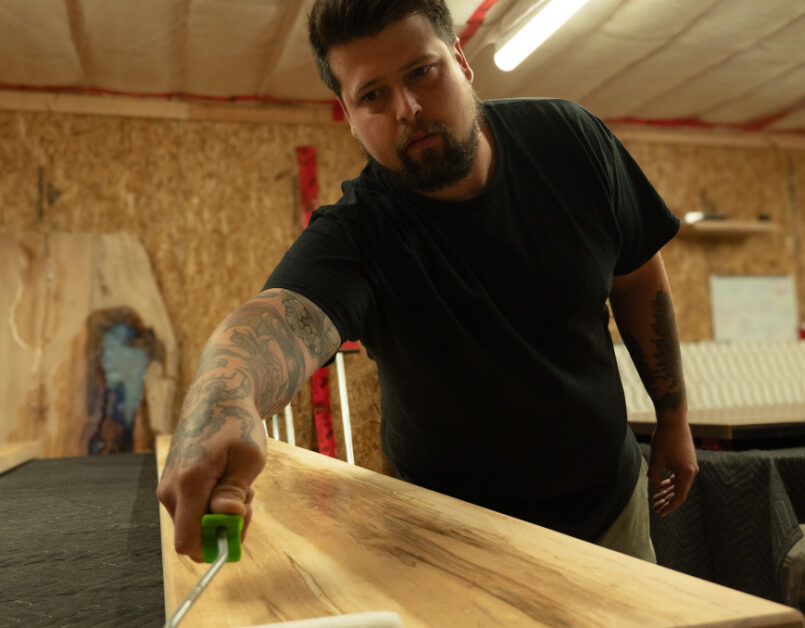The Do’s and Don’ts of Refinishing Old Hardwood
Hardwood furniture and slabs carry character, warmth, and a timeless appeal that few materials can match. Over the years, daily use, spills, and exposure to sunlight can leave even the finest hardwood pieces looking worn or faded. Refinishing is the perfect way to restore their natural beauty while preserving their longevity.
At Vinogradofff, we know the transformation that refinished hardwood can bring to a home or workshop. But refinishing isn’t as simple as sanding and applying a coat of finish. To achieve professional results and avoid costly mistakes, here are the key do’s and don’ts of refinishing old hardwood.
The Do’s of Refinishing Hardwood
1. Do Inspect Your Piece First
Before starting, examine the condition of your furniture or slab. Look for deep scratches, water stains, or areas of rot or cracking. Understanding the condition of the wood helps you determine how much sanding or repair is needed and ensures your refinishing project is a success.
2. Do Use the Right Tools and Materials
Professional results come from using the proper tools. High-quality sandpaper, brushes, or applicators for stain and finish will make a huge difference in the final appearance. Even if you’re refinishing a single table or slab, investing in proper materials prevents uneven finishes, streaks, or blotchy surfaces.
3. Do Sand Carefully
Sanding is essential for removing old finish and creating a smooth surface. Start with a coarse grit to remove scratches and old coatings, then move to finer grits for a polished finish. Always sand with the grain of the wood, never against it, to prevent scratches or swirl marks.
4. Do Choose a Finish That Matches the Wood’s Character
The finish you select affects both the look and durability of the piece. Oil-based finishes add warmth and depth, while water-based options highlight the wood’s natural color. For frequently used furniture, consider a durable polyurethane or lacquer finish. Matching the finish to the piece’s intended use ensures longevity and beauty.
5. Do Allow Proper Drying and Curing Time
After applying stain or finish, allow sufficient drying and curing time. Rushing can trap dust, fingerprints, or bubbles in the coating, ruining your work. Patience ensures a flawless, long-lasting finish.
The Don’ts of Refinishing Hardwood
1. Don’t Skip Prep Work
Thorough preparation is essential. Remove hardware, clean the wood, and repair any cracks or dents before sanding. Dust, dirt, or residue left behind can affect adhesion and create imperfections in the finish.
2. Don’t Over-Sand or Remove Too Much Wood
While sanding is important, removing too much wood can permanently alter the piece or weaken joints. Stick to a careful sanding progression, and always assess the wood thickness before proceeding.
3. Don’t Ignore Safety Precautions
Sanding dust and chemical finishes can be hazardous. Always wear protective gear, including gloves, goggles, and a mask. Work in a well-ventilated area to prevent inhaling fumes, especially when using solvent-based finishes.
4. Don’t Apply Stain or Finish Unevenly
Uneven application results in blotches, streaks, or inconsistent color. Stir the stain, apply thin, even coats, and wipe off excess promptly. Testing a small hidden area first can prevent surprises on the main surface.
5. Don’t Rush the Process
Refinishing old hardwood takes time. From sanding to staining to finishing, each step requires patience and attention. Rushing increases the risk of mistakes and compromises the piece’s final appearance.
Should You DIY or Hire a Professional?
Refinishing furniture and slabs can be rewarding, but mistakes are costly. Over-sanding, uneven staining, or improperly applied finishes can ruin a piece you love. Hiring a professional ensures expert results and saves both time and stress.
At Vinogradofff, we specialize in restoring and enhancing the natural beauty of hardwood, from walnut slabs to one-of-a-kind tables. Our team combines expert techniques with high-quality finishes to bring out the character of every piece we touch.
Final Thoughts
Refinishing old hardwood is one of the best ways to preserve the charm and value of furniture or woodworking projects. By following the do’s and don’ts, you can avoid common pitfalls and achieve stunning results. Whether you tackle the project yourself or work with a professional, careful preparation, patience, and respect for the wood’s natural character are essential.
At Vinogradofff, we believe hardwood is more than just material—it’s the foundation of craftsmanship and timeless design. If your slabs, tables, or other pieces need a refresh, our team is ready to help restore them to their full potential.





